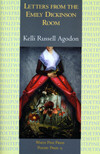Letters from the Emily Dickinson Room
Letters from the Emily Dickinson Room, by Kelli Russell Agodon, is a collection of charming, intelligent poems that invoke the idea of a modern day Emily addressing the world from the safety of her room. Agodon incorporates anagrams in many of the poems; for example, in “Believing Anagrams,” “funeral” becomes “real fun,” “Emily Dickinson” becomes “inky misled icon” and “poetry” becomes “prey to.” While with some poets this kind of word play can become gimmicky, Agodon masterfully weaves the words into the poem in a natural, organic way. “In the 70s, I Confused Macramé for Macabre” is another poem where language is taken apart and put back together, using the words incorrectly in two different memories, as the speaker “wanted / my mother to remind me / that sometimes we survive.”
Letters from the Emily Dickinson Room, by Kelli Russell Agodon, is a collection of charming, intelligent poems that invoke the idea of a modern day Emily addressing the world from the safety of her room. Agodon incorporates anagrams in many of the poems; for example, in “Believing Anagrams,” “funeral” becomes “real fun,” “Emily Dickinson” becomes “inky misled icon” and “poetry” becomes “prey to.” While with some poets this kind of word play can become gimmicky, Agodon masterfully weaves the words into the poem in a natural, organic way. “In the 70s, I Confused Macramé for Macabre” is another poem where language is taken apart and put back together, using the words incorrectly in two different memories, as the speaker “wanted / my mother to remind me / that sometimes we survive.”
There is an element of self-analysis, self-dissection, and resisting correction in the book; in “Discovering the Tasmanian Devil is my Life Coach” the speaker is told “to rip apart the wildflowers without feeling / guilty for what was” and “to spin naked through a continent.” These images again invoke the modern day Emily Dickinson, being told, against her character (or what we as readers suppose of her character), to loosen up.
Emily Dickinson is often viewed as an isolated, distanced poet, and the speaker in “Ghosts” relates to this as she “live[s] in a house / of irises where I am a ghost / searching for words / in my family’s mouths.” This element of Dickinson’s character is also seen in that many of the poems are letters—the author addresses people formally, rather than face to face.
Agodon’s writing is immersive, reminding the reader of Dickinson while also resisting her through her style and references to modern day living.





